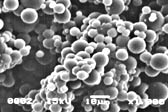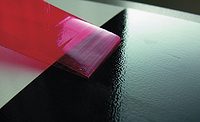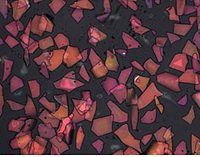Soft Feel Effect with Silicone Additives

Plastics have been used successfully and incorporated at increasing quantities in automotive engineering for many years. Examples of applications include: in the car body, in the passenger compartment and for certain engine components where steel is being replaced wholly or in part by plastics. As well as reducing weight, plastics have a number of other advantages. They provide greater scope for design, the potential for integrating components, improved aerodynamic properties due to appropriate molding, and increased energy absorption in the event of a crash.1
For greater comfort in the passenger compartment, the plastic parts must be lined with foil and textiles. Most of the foils are PVC foils, which can be problematic for the disposal of old vehicles.
Alternatively, coatings can be used because it is much easier to achieve color consistency with coatings than reproducibility of colored plastics. When developing coatings for this application, it is important to avoid the usage of solvents to prevent solvent emissions. Furthermore, an attractive, high-quality surface is desired.
Soft-feel coatings have tactile properties, are mainly matte, and both look and feel similar to leather or velvet. They can also improve the weather resistance against sunlight and scratch resistance.2
Soft-feel coatings are used in other industries, e.g., the electronics industry (computers, laptops, mobile phones) and the furniture industry to obtain a nice to touch, matte, mar-resistant and good-looking surface. If a certain appearance is required, it can be obtained by applying the coating onto a textured plastic substrate.
The successful formulation of soft-feel coatings requires the use of certain softer binders, e.g., aqueous hydroxy functional dispersions in combination with water-emulsifiable polyisocyanates to formulate two-pack systems.3 The combination of organic and inorganic compounds can further enhance the soft-feel effect.4 However, organic compounds based on urea formaldehyde can emit formaldehyde and, therefore, new solutions are required.
This article discusses the use of a new silicone additive technology that can be used in coatings to provide leather- or velvet-like appearance.

Conventional Silicone Additives for Coatings
Silicones, or polydimethylsiloxanes (PDMS), are highly surface-active materials due to the arrangement of methyl groups on the flexible, inorganic backbone of alternating silicon and oxygen atoms.5 A generalized structure is shown in Figure 1. Due to the rapid presentation of methyl groups at an interface, the overall free energy of the coatings can be reduced considerably. This is an important aspect of the leveling process and is also involved in substrate wetting phenomena. The presence of silicone on the surface of a cured film will improve lubricity, commonly referred to as slip, due to the low intermolecular forces between the silicone polymer chains. Mar resistance and anti-blocking are other features enhanced by the presence of silicone polymers at the film surface.PDMS fluids are insoluble in water and will float on the liquid surface. Therefore, they will not give the desired features in waterborne coatings. The large droplets of silicone fluid will give surface defects. However, some degree of incompatibility must be present to drive the additive to the surface of the coating film during the drying process to provide benefits such as soft feel and mar resistance. Achieving this compatibility balance has been one of the key goals in silicone additive development. The ability to modify compatibility of silicone additives either physically or chemically has resulted in a range of silicone additives for waterborne and radiation-cured coatings.
- Physical modifications
- Pre-dispersing the PDMS as an emulsion
- A self-dispersing PDMS compound
- Chemical modification
- Grafting hydrophilic groups onto the PDMS chain

The most popular hydrophilic groups used for the chemical modification of PDMS are polyether chains. Figure 2 shows the general structure of a silicone-polyether copolymer. The polyether chains can be attached at points along the length of the silicone backbone, giving a comb-like structure. They can also be attached to the ends of the silicone polymer, giving a linear structure. The architecture of the copolymer has a profound effect on the behavior as a slip additive. Optimized structures have been identified by designed experimentation to give suitable combinations of compatibility and desired effect, such as slip, leveling, or wetting. Compatibility is particularly important in clear coatings, where gloss reduction or haze cannot be tolerated.
Since these copolymers have surfactant character, they often exhibit a combination of features such as improved substrate wetting, mar resistance and leveling.

Developments - Soft Feel Additives
A development in our laboratories involves a combined physical and chemical modification of PDMS (see Figure 3). Here the fluid droplets in a PDMS emulsion are crosslinked giving a three-dimensional elastomeric network in the form of flexible silicone particles. These are available as aqueous suspensions or dry powders. Reactive groups such as epoxy can be introduced, which can be an advantage in some coating systems.The aqueous suspensions are suitable for the use in waterborne coatings; the dry powders are suitable for both solventborne and radiation-cured coatings.
The mean particle size of these silicone elastomers is between 2 and 10 Km, depending on the product grade.
Because of the elastomeric network of these products and their fine particle size, they will provide a matte coatings surface that is smooth and silky to the touch. Furthermore, they will improve the scratch resistance.

Performance in Coating Formulations
The evaluations of silicone additives were performed using different two-pack formulations for pigmented soft-feel coatings based on polyurethane/polyester dispersions and water-emulsifiable polyisocyanates. The evaluations were focused on soft-feel effect, slip, gloss, scratch resistance, surface appearance and adhesion.The surface appearance was good for all tested coatings; there were no side effects such as cratering or pinholing. The recoatability with the same coating did not cause any adhesion problems (DIN 53 151, cross hatch) in any tested formulation.
Figure 4 shows the soft-feel effect for different silicone additives. The control has a poor soft feel effect that cannot be improved with traditional silicones such as silicone polyethers or silicone compounds. The addition of two different soft-feel suspensions shows improved results. Both suspensions have an active content of 50% silicones in water. Suspension 1 has an average particle size of 2Km, suspension 2 has an average particle size of 3Km. Best performance is obtained with 5% addition of soft feel emulsion 2.

The results show that the soft-feel suspensions are not reducing the coefficient of friction at the dosages tested. An explanation for this behavior can be the rubbery surface of the coating due to the accumulation of elastomeric silicone particles at the surface. However, there is a need to investigate this further at higher dosages. As expected, the traditional additives are reducing the coefficient of friction, providing the coating with improved slip properties.
While the coefficient of friction measurement occurs at the coating's surface, which does not cause any damage, a more rigid test method is required to test the scratch resistance. On the other hand the tested silicone additives are accumulating at the coatings surface and will therefore influence mainly the surface properties, rather than the bulk properties of the coating.


Conclusion
Silicone additives have progressed enormously since the first use of PDMS fluids in solventborne coatings. New chemical structures have evolved using chemical or physical modifications of PDMS to improve coating surface properties of more environmentally acceptable systems such as aqueous coatings.Our aim in this article was to show that the versatility of silicone technology lends itself extremely well to specific demands made on plastic coatings. Combining a physical and chemical modification to PDMS has generated a group of products that provide a soft-feel effect, improved scratch-resistance and reduced gloss of aqueous coatings.
For more information on soft-feel coatings, contact Dow Corning GmbH, Rheingaustrasse 34, 65201 Wiesbaden, Germany; phone + 49 611 237233; fax + 49 611 237640; e-mail angela.cackovich@dowcorning.com; or Circle Number 136.
References
1 PPCJ, 5/98.2 DuPont Magazine, 3/97.
3 Bayer Inform, order LS 5622, 9/98.
4 Coating 10/89, H. H¿ndgesberg.
5 Owen, M.J. "The Surface Activity of Silicones: A short review," I&EC Prod. Res. Dev., 10 (1980), 97.
Links
Looking for a reprint of this article?
From high-res PDFs to custom plaques, order your copy today!






